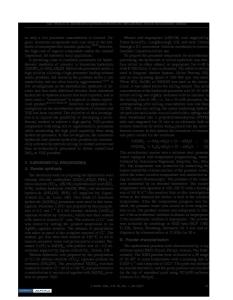A novel structural mesoporous alumina/yttrium doped zirconia nanocrystalline composite derived by solvothermal approach
- PDF / 1,868,279 Bytes
- 6 Pages / 612 x 792 pts (letter) Page_size
- 61 Downloads / 331 Views
Xin Michael Wang Manchester Materials Science Centre, The University of Manchester and UMIST, Manchester, M1 7HS, United Kingdom
Jianlin Shiaa) State Key Lab of High Performance Ceramics and Superfine Microstructure, Shanghai Institute of Ceramics, Chinese Academy of Sciences, Shanghai 200050, China
Ping Xiaob) Manchester Materials Science Centre, The University of Manchester and UMIST, Manchester, M1 7HS, United Kingdom
Dongsheng Yan State Key Lab of High Performance Ceramics and Superfine Microstructure, Shanghai Institute of Ceramics, Chinese Academy of Sciences, Shanghai 200050, China (Received 10 May 2004; accepted 29 July 2004).
A novel structural mesoporous alumina (40 mol%)/yttrium doped zirconia nanocrystalline composite has been synthesized by a solvothermal process using ethanol and ethylene glycol as a co-solvent. X-ray diffraction, thermogravimetry/ differential scanning calorimetry, Fourier transform infrared, transmission electron microscopy, and nitrogen adsorption are used for the structural characterization. This novel mesoporous alumina/zirconia nanocomposite presents nanocrystalline zirconia particles with a uniform size less than 5 nm surrounded by alumina, forming a kind of core-shell structure after calcined at 800 °C. The mesostructural composite has high surface area (higher than 250 m2/g) and a narrow pore-size distribution of about 3.2 nm throughout the composite sample. The uniformly distributed nanocrystalline zirconia particles and the surrounding wormlike alumina framework act as the inorganic wall for the mesopores.
I. INTRODUCTION
Recently, the study of composite nanostructures and nanoparticles with a specific size and morphogenesis has attracted great interest for the fact that their properties are closely related to their particle sizes, compositions, and nanostructures.1,2 Zirconia materials have found wide and useful applications as catalysts, catalyst supporters, high-performance ceramics, thermal-barrier coatings, and so forth.3,4 Alumina is one of the most widely used ceramic materials due to its high elastic modulus, high wear resistance, high-temperature stability, and so on.5–7 The addition of Al2O3 to zirconia has been reported to Address all correspondence to these authors. a) e-mail: [email protected] b) e-mail: [email protected] DOI: 10.1557/JMR.2005.0034 42
http://journals.cambridge.org
J. Mater. Res., Vol. 20, No. 1, Jan 2005 Downloaded: 14 Mar 2015
improve the properties of zirconia, such as suppressing grain growth during sintering8 and greatly increasing its mechanical properties.9 Thus, alumina/zirconia nanocomposite material has attracted increasing interests in recent years due to the further-enhanced performance relative to either single phase Al2O3 or ZrO2 materials. Nevertheless, the preparation and characterization of zirconia-alumina nanocomposite particles with a specific morphogenesis starting from ion-level homogeneous precursors has been seen rarely in the literature. Mesoporous materials, especially mesoporous composite oxides, have re
Data Loading...











